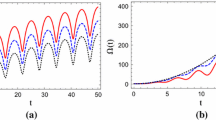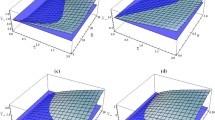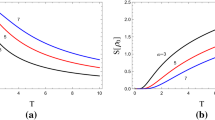Abstract
In this manuscript, we study the Wehrl entropy of entangled oscillators. This semiclassical entropy associated with the phase-space description of quantum mechanics can be used for formulating uncertainty relations and for a quantification of entanglement. We focus on a system of two coupled oscillators described within its Segal–Bargmann space. This Hilbert space of holomorphic functions integrable with respect to a given Gaussian-like measure is particularly convenient to deal with harmonic oscillators. Indeed, the Stone–von Neumann theorem allows us to work in this space in a full correspondence with the ladder operators formalism. In addition, the Husimi pseudoprobability distribution is directly computed within the Segal–Bargmann formalism. Once we obtain the Husimi function, we analyse the Wehrl entropy and mutual information.
Graphic abstract




Similar content being viewed by others
Data Availability
This manuscript has no associated data or the data will not be deposited. Data sharing is not applicable to this article as no datasets were generated or analysed during the current study.
Notes
This expression holds as long as each term is finite. Clearly, this is our case for finite coupling \(\eta \).
References
P. Dirac, Principles of Quantum Mechanics (Oxford University Press, Oxford, England, 1982)
C. Zachos, D. Fairlie, T. Curtright, Quantum Mechanics in Phase Space An Overview with Selected Papers (World Scientific, Singapore, 2005)
E. Wigner, On the quantum correction for thermodynamic equilibrium. Phys. Rev. 40, 749–759 (1932). https://doi.org/10.1103/PhysRev.40.749
E. Weyl, Quantenmechanik und gruppentheorie. Z. Phys. 46, 1–46 (1927)
K. Husimi, Some formal properties of the density matrix. Proc. Physico-Math. Soc. Jpn. 3rd Ser. 22(4), 64–314 (1940). https://doi.org/10.11429/ppmsj1919.22.4_264
H.-W. Lee, Theory and application of the quantum phase-space distribution functions. Phys. Rep. 259(3), 147–211 (1995). https://doi.org/10.1016/0370-1573(95)00007-4
I.E. Segal, Mathematical Problems of Relativistic Physics: With an Appendix on Group Representations in Hilbert Space (American Mathematical Society, Providence, RI, 1967)
V. Bargmann, On a Hilbert space of analytic functions and an associated integral transform part I. Commun. Pure Appl. Math. 14(3), 187–214 (1961). https://doi.org/10.1002/cpa.3160140303
B. Hall, Holomorphic methods in analysis and mathematical physics. Contemp. Math. (2000). https://doi.org/10.1090/conm/260/04156
R. Horodecki, P. Horodecki, M. Horodecki, K. Horodecki, Quantum entanglement. Rev. Mod. Phys. 81(2), 865–942 (2009). https://doi.org/10.1103/revmodphys.81.865
A. Einstein, B. Podolsky, N. Rosen, Can quantum-mechanical description of physical reality be considered complete? Phys. Rev. 47, 777–780 (1935). https://doi.org/10.1103/PhysRev.47.777
J.S. Bell, On the Einstein Podolsky Rosen paradox. Phys. Phys. Fiz. 1, 195–200 (1964). https://doi.org/10.1103/PhysicsPhysiqueFizika.1.195
D.N. Makarov, Coupled harmonic oscillators and their quantum entanglement. Phys. Rev. E 97, 042203 (2018). https://doi.org/10.1103/PhysRevE.97.042203
V. Vedral, Entanglement in the second quantization formalism. Central Eur. J. Phys. 1, 289–306 (2003) arXiv:quant-ph/0302040. https://doi.org/10.2478/BF02476298
D. Han, Y. Kim, M. Noz, Illustrative example of Feynman’s rest of the universe. Am. J. Phys. 67(1999). https://doi.org/10.1119/1.19192
S.S. Mizrahi, M.A. Marchiolli, Pseudo-diffusion equation and information entropy of squeezed-coherent states. Phys. A Stat. Mech. Appl. 199(1), 96–115 (1993). https://doi.org/10.1016/0378-4371(93)90100-I
M.A. Marchiolli, E.C. Silva, D. Galetti, Quasiprobability distribution functions for finite-dimensional discrete phase spaces: spin-tunneling effects in a toy model. Phys. Rev. A 79, 022114 (2009). https://doi.org/10.1103/PhysRevA.79.022114
J. Klauder, B. Skagerstam, Coherent states. World Scientific (1985). https://doi.org/10.1142/0096. https://www.worldscientific.com/doi/abs/10.1142/0096
N.N. Bogoljubov, V.V. Tolmachov, D.V. Širkov, A new method in the theory of superconductivity. Fortschr. Phys. 6(11–12), 605–682 (1958). https://doi.org/10.1002/prop.19580061102
P. Shanta, S. Chaturvedi, V. Srinivasan, G.S. Agarwal, C.L. Mehta, Unified approach to multiphoton coherent states. Phys. Rev. Lett. 72, 1447–1450 (1994). https://doi.org/10.1103/PhysRevLett.72.1447
K. Takahashi, Wigner and Husimi functions in quantum mechanics. J. Phys. Soc. Jpn. 55(3), 762–779 (1986). https://doi.org/10.1143/JPSJ.55.762
A. Wehrl, General properties of entropy. Rev. Mod. Phys. 50, 221–260 (1978). https://doi.org/10.1103/RevModPhys.50.221
D. Janzing, in Entropy of Entanglement, ed. by D. Greenberger, K. Hentschel, F. Weinert (Springer, Berlin, Heidelberg, 2009), pp. 205–209. https://doi.org/10.1007/978-3-540-70626-7_66
S. Floerchinger, T. Haas, H. Müller-Groeling, Wehrl entropy, entropic uncertainty relations, and entanglement. Phys. Rev. A (2021). https://doi.org/10.1103/physreva.103.062222
Acknowledgements
We are grateful to Ángel Rivas for useful discussions. This work was partially supported by the MICINN (Ministerio de Ciencia e Innovación, Spain) project PID2019-107394GB-I00/AEI/10.13039/501100011033 (AEI/FEDER, UE). This article/publication is based upon work from COST Action COSMIC WISPers CA21106, supported by COST (European Cooperation in Science and Technology). JARC acknowledges support by Institut Pascal at Université Paris-Saclay during the Paris-Saclay Astroparticle Symposium 2022, with the support of the P2IO Laboratory of Excellence (program “Investissements d’avenir” ANR-11-IDEX-0003-01 Paris-Saclay and ANR-10-LABX-0038), the P2I axis of the Graduate School of Physics of Université Paris-Saclay, as well as IJCLab, CEA, APPEC, IAS, OSUPS, and the IN2P3 master project UCMN.
Author information
Authors and Affiliations
Contributions
All authors contributed equally to this manuscript.
Corresponding author
Rights and permissions
Springer Nature or its licensor (e.g. a society or other partner) holds exclusive rights to this article under a publishing agreement with the author(s) or other rightsholder(s); author self-archiving of the accepted manuscript version of this article is solely governed by the terms of such publishing agreement and applicable law.
About this article
Cite this article
Alonso-López, D., Cembranos, J.A.R., Díaz-Guerra, D. et al. Wehrl entropy of entangled oscillators from the Segal–Bargmann formalism. Eur. Phys. J. D 77, 43 (2023). https://doi.org/10.1140/epjd/s10053-023-00629-1
Received:
Accepted:
Published:
DOI: https://doi.org/10.1140/epjd/s10053-023-00629-1




